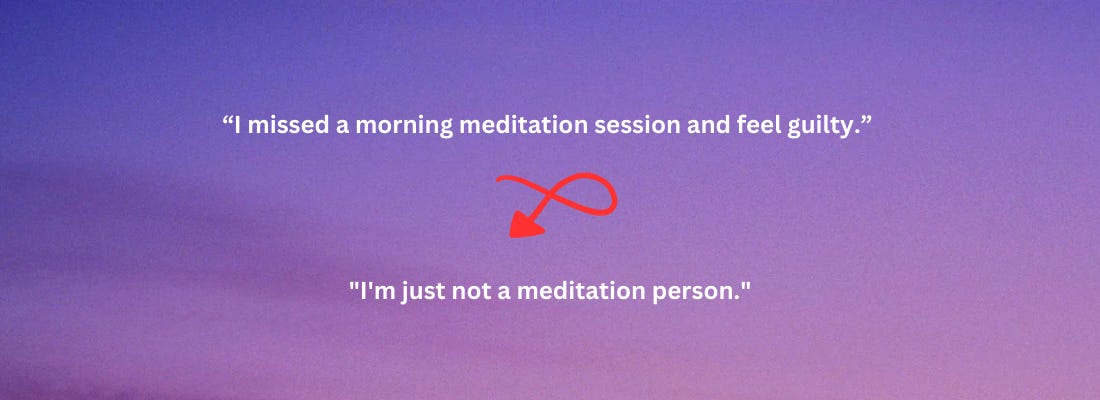Stop Making Emotional Decisions by Asking: “Is That True?”
Choices driven by emotions don’t reflect your authenticity.
Your brain is a miracle.
It contains 100 billion neurons that help you experience up to 60,000 thoughts per day and constantly changes in response to your environment throughout your life.
However, your brain’s also very bad at some things.
For example, multitasking. What really occurs is something called ‘rapid task-switching,’ which significantly reduces performance and over-depletes cognitive resources.
And your brain’s particularly bad at waiting until it has sufficient evidence before arriving at a conclusion—meaning that it’s particularly good at forming false beliefs—because of cognitive tools called heuristics.
Why Heuristics Help & Hinder Your Decision-Making
Your brain values processing speed.
Therefore, to help you make decisions as quickly as possible, it creates mental “shortcuts,” called heuristics.
You use many different heuristics in your daily life, but a common one is the affect heuristic: coming to an emotional conclusion rather than one based on objective information. For example:
Emotional trigger: You miss a morning meditation session and feel guilty.
Negative affect activation: Guilt triggers frustration and an underlying belief of inadequacy.
Risk/benefit distortion: You reinforce your negative emotional state with thoughts like:
"I can never stick with meditation" (overestimating your risk of failure) or,
"Meditation probably won’t work for me anyway" (underestimating benefits)
Confirmation filtering: From there, you selectively recall past missed sessions and ignore the many other times you practiced, whether on the cushion or in the real world.
Then, here’s the crux:
False conclusion formation: You decide, "I'm just not a meditation person" or "I lack the discipline to practice mindfulness," despite evidence to the contrary.
From here, it becomes a self-fulfilling prophecy. Your new “I’m not” belief reduces your motivation to continue practicing, making you much more likely to miss future sessions, further reinforcing your false narrative.
This is a good example of how a momentary emotional reaction to a missed session can trigger a cascade of biased thinking that leads to false conclusions. All because your brain processes emotional responses faster than it analyzes evidence.
Which is why I think it’s a good idea to have a pocket-sized system for detecting your own bullshit.
Halting Emotionally Informed Conclusions by Asking: “Is That True?”
Try this: Reimagine the example above. But instead of going step-by-step, move directly from the first step to the last, skipping everything in between. The progression looks like this:
Viewed from this perspective, you can clearly see that the conclusion does not follow from the premises.
Instead, all the emotional rationalization sandwiched in between is required for you to believe that this verdict makes even the slightest bit of sense.
How do you halt this progression? Here’s where asking, “Is that true?” enters the picture.
Watch how dropping this question anywhere in the process immediately expands your mental space:
A: “Is the guilt I feel for missing one meditation session true?”
A: “It’s natural to feel a little bummed, but this is a very tiny thing and not worth saddling myself with any guilt over.”
“Is the inadequacy caused by this guilt true?”
A: “Again, it’s ok to feel less-than-stellar. But I am not lacking in any way.”
“Is it true that I never stick with meditation?”
A: “Stepping back, I can see how many times I’ve meditated recently, providing proof that this miss was just a blip.”
In a nutshell, asking, "Is that true?" engages your rational thinking, which can help temper emotional responses by creating a pause between your initial reaction and judgment, allowing for more careful consideration.
3 Steps for Using “Is That True” to Reach Less Emotional Conclusions
Here’s how you can use “Is that true?” as an effective false-conclusion detector:
Step 1: Pause
When you notice negative thoughts or conclusions forming, immediately ask, "Is that true?"
This pauses the automatic progression and creates a critical moment of space between stimulus and response.
Step 2: Request
Regardless of your answer, follow up with, "What evidence supports this belief?" and "What evidence contradicts it?"
Requesting evidence forces your brain into empirical mode rather than relying on emotional reasoning.
Step 3: Consider
Ask, "What other interpretations might explain this situation?"
Considering alternative explanations weakens the certainty of your initial conclusion.
Did you become aware of a negative thought or conclusion related to what you consider? Return to step one.
Together, these simple questions can transform how you interact with your emotions and shift their power over your decisions.
Use This 3-Word Emotional Lever to Your Advantage
Emotions can change your mental state before you’re consciously aware. Even once they do enter your consciousness, it’s still easy to let them decide for you.
Instead, reclaim your power and break the thought cycle by asking, “Is that true?”
Sure, the process might feel a little clunky at first, but like learning anything else, it will get faster over time.
Remember: Small steps, repeated daily, lead to significant results.
And it all can all begin with a simple three-word question.







Hi Derek. This article hits on a powerful—and often overlooked—truth: our emotions don't just color our thoughts, they create entire narratives that feel factual but are often fiction. The “Is that true?” question is such a deceptively simple lever. It interrupts the autopilot loop of guilt, inadequacy, and false identity just long enough for the rational mind to catch up.
In my leadership work, I've seen entire teams spiral into poor decision-making because no one paused to question the emotional "story" beneath the surface. The affect heuristic isn't just personal—it's organizational. A pocket-sized BS detector, as you brilliantly put it, is exactly what we need. Thank you for articulating this so clearly and practically.
Subscribing now.
— Matt DiGeronimo